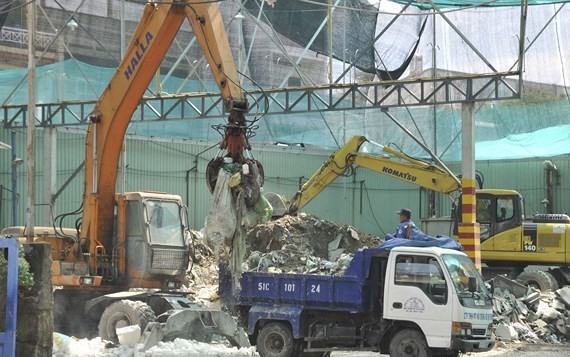
The city’s Department of Natural Resources and Environment said that construction waste accounts for around 20 percent of urban household waste. Thus, if domestic waste is estimated at more than 9,000 tons per day, the amount of construction waste will be around 1,800 tons per day. This figure is forecasted to rise to nearly 3,000 tons per day by 2025.
According to the department, construction waste is mainly collected in the inner city. Meanwhile, recent reports by districts said that construction is from three sources with different properties and development characteristics. Particularly, construction waste is from renovation area, new construction area and area mixed between renovation and new construction.
However, until now, collecting and treating of construction waste has not been done separately. Representatives of many public service and environmental sanitation services companies said that in reality, they usually collect construction waste together with domestic waste as waste’s owners –mostly, households – usually dump construction waste into domestic one. After that, it is transported to waste treatment plants and buried with domestic waste. As for new constructions, construction waste is usually a lot, around hundreds kilograms upwards, waste owners usually hire cargo tricycles to dump construction waste at vacant land or spontaneous landfills.
The HCMC Urban Environment Company Limited collects construction waste separately but usually for some large-scale constructions which have already signed construction waste collecting contracts with it. Construction waste then will be recycled and reused partly. Of which, broken concrete, broken bricks and tiles are used to fill the foundation of building constructions or cover for landfills. Steel, broken water pipes, packing, plastic and glass are recycled.
The recyclability of construction waste is quite high. According to environmental experts, if construction waste is collected and recycled properly, the ratio of recyclable construction waste might be up to 90 percent. Only 10 percent of construction waste must be buried, minimizing the area of land used for landfills. Unfortunately, recycling and reusing of construction waste in the city is mostly spontaneous. The city has not had any industrial-scale construction waste treatment plant which meets environmental hygiene and safety standards.
Experts said that the city should rely on its internal waste treatment capacity to quickly put into operation construction waste treatment plants in order to tackle these problems. Investment for building construction waste treatment plant is quite simple and does not depend much on public investment as investor can create a part of revenue from socialization and the waste’s owners.
On the other hand, the risks of secondary pollutants generating from recycling construction waste are not high. The remaining problem is that the city needs to determine location, area of land to be licensed for investment and unit price for collecting and treating construction waste. At the same time, the city needs to promulgate policies to socialize investment for this activity, of which, the city should prioritize Vietnamese firms.
The Department of Natural Resources and Environment of Ho Chi Minh City has brought out two collecting and transporting solutions to meet requirements for construction waste treatment. First of all, construction waste could be collected and transported via separate construction waste transfer stations. The unit which collects domestic waste will be responsible for collecting construction waste. Or construction waste will be directly contracted between the waste’s owner and the waste collector then transported to an urban solid waste treatment plant or being used to fill up land site.
Obviously, in recent years, the speed of urbanization in the city has increased rapidly, the demand to repair, renovate and build new houses along with public constructions has also increased strongly. The amount of construction waste is increasing, not only in inner city districts but also in the suburbs. Therefore, building transfer stations and construction waste treatment plants is extremely urgent.
























